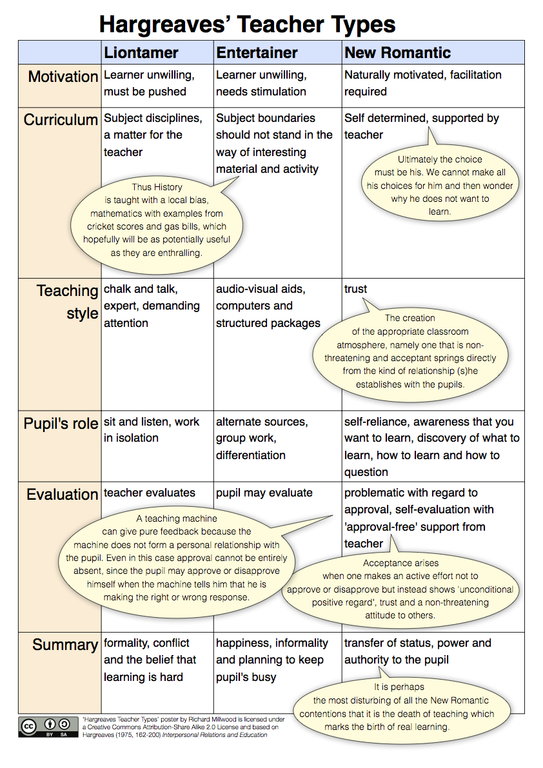Education
The ideas of Hargreaves (1975) concerning the interpersonal relationship between teacher and learner, Deming (1982) regarding the pursuit of quality and the cybernetics systems theory from Beer (1985) and Ashby (1956) have been influential and are discussed in this section.
Teacher and Learner
In the early years of my design practice, I focussed on learning in the microcosm of the individual learner. Within this context, my attention was on the use of the computer rather than the wider process of education signified by the classroom. When first registering for PhD in 1986, I was invited to produce a qualifying essay (Millwood 1987) which I based on teacher stereotypes identified by Hargreaves (1975, 162-200) and set out in table 7.
Table 7: Hargreaves' teacher types
This diversity of aims, objectives and values devised by Hargreaves was new for me, not only as a perspective on education but in how the design of technology enhancements might take account of the context of use and indeed support the aims of such de-schoolers as Illich (1970) and Holt (1976). In my essay (Millwood 1987) I made a connection between McDonald et al's (1977) paradigms for computer assisted learning and Hargreaves' (1975, 162-200) teacher stereotypes that helped me understand why teachers might propose designs in different ways according to the predominant teacher stereotype in their practice.
This analysis must be treated with caution as it does not aim to categorise teachers, but as Hargreaves points out:
"the reader must remember that these are 'ideal types' in Weber's sense of the term."
and that:
"it would be a disastrous mistake to think that the teaching profession can be divided neatly into three groups. Whilst some teachers may be much closer to one type than to others, many teachers are a complex mixture of the three types."
(Hargreaves 1975, 163)
Educational quality and improvement
In producing the CD-ROM for the 'Business of Quality' in the Renaissance Project, an interactive multimedia account of Deming's theories for improvement in manufacturing and business (Deming 1982), I learnt about the notion of quality and how it can be monitored. What came as a revelation was the idea that customers should be delighted, not simply satisfied in order to succeed in competition with other companies. I found these ideas transformative in my own thinking about educational institutions and their improvement, and connected to the social sciences notion of an action research approach with the plan–do–check–adjust cycle. It gave foundation to my later work to design education organisations to be profoundly learner centred ( TeacherNet UK; [P9] Ultraversity Project ).
Educational community and variety
The development of educational organisations online presented many new challenges to the designer, and tacitly these were solved by encouraging online learning community to develop where peers expected to learn from each other as well as from content, experts or tutors. This thinking became clearer when contrasting the [P9] Ultraversity Project and the [P10] Inter-Disciplinary Inquiry-Based Learning (IDIBL) project. The first was considered highly successful and the second struggled to make headway. By applying the concept of 'variety' in the context of Cybernetics (Beer 1985; Ashby 1956), it was clear that the successful design benefitted from the absorption of variety in student states by inviting them to build relationships of mutual respect and support with each other. This meant that the facilitation team, tasked with leading the community, were able to manage the variety that remained without being swamped with so many diverse questions and problems (Millwood and Powell 2011).
Educational design
In my practice, applying the ideas of design to education was initially tacit in nature, but later influenced by the explicit principles developed by theorists such as Gagné (1985). These are based on an analysis of instructional events (and corresponding cognitive processes):
- gaining attention (reception)
- informing learners of the objective (expectancy)
- stimulating recall of prior learning (retrieval)
- presenting the stimulus (selective perception)
- providing learning guidance (semantic encoding)
- eliciting performance (responding)
- providing feedback (reinforcement)
- assessing performance (retrieval)
- enhancing retention and transfer (generalization).
But these events are focussed on what the teacher should do, with the assumption of Hargreaves' 'liontamer' or 'entertainer' stereotypical style (Hargreaves 1975, 162-200). It also focusses on the lesson, rather than the complete scope of educational experience for the learner. This led me to analyse education from the perspective of the learner, which is the subject of the analysis The Learner at the Centre [A3] to be found in the Claim.
(Words: 901 )


